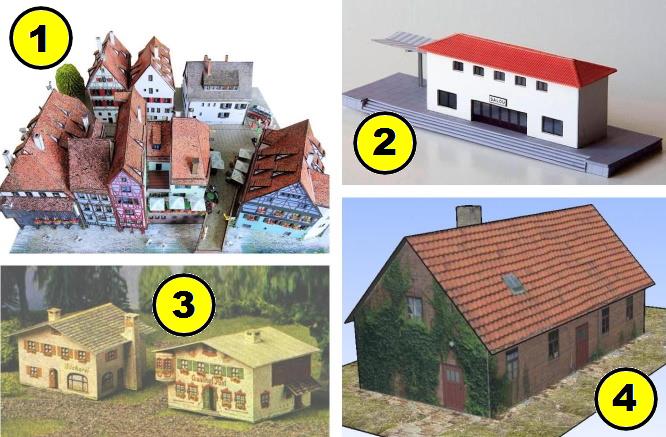This modular papercraft of a medieval castle is offered by the educational website Hugo l'escargot.
The castle has been available online for a few years, and I hadn't posted it here on the blog because I never found an image of it assembled, or even instructions for it.
So I decided to build it in 3D, using Sketchup, and what I found while assembling it is that you can create various configurations, depending on the number of pieces and how you connect them to each other.
Here in this post, I present two examples that I created using the pieces available in the downloadable template.
Below each example, I've placed an image of the individual pieces. You'll notice that there are numbers below each piece.
The numbers indicate how many times I used each piece in the assembly.
I hope this helps those interested in building their own modular castle. It's a fairly easy project to execute and perfect for spending a productive afternoon with the kids, who will enjoy developing manual skills and exercising their imagination.
In the downloadable template, there's also a round tower, and the only reason I didn't use it in the examples in this post is that I couldn't assemble it properly in Sketchup. The 3D construction was easy, but I couldn't apply the textures because of the rounded shapes.
Hugo l'escargot is a fictional character who has become popular in various forms of media, especially in cartoons and games. This character has appeared in a variety of contexts, including cartoons, children's books, educational games, and language learning materials.
In many cases, Hugo is used as a central character to teach basic skills such as mathematics, reading, science, and foreign languages, especially for preschool and early school-aged children.
Hugo l'escargot is often associated with French culture due to his name and the French language. He can be found in educational resources designed to teach French as a second language or as a foreign language.
"L'escargot" is the French word for "snail." Hugo is often depicted as an anthropomorphic snail, meaning he has human-like characteristics, such as speaking and acting similarly to humans.
Additionally, Hugo can also be found in computer games and educational apps, often in interactive adventures that involve solving puzzles and challenges to promote children's learning and cognitive development.
Este papercraft modular de um castelo medieval é oferecido pelo site educativo Hugo l'escargot.
O castelo já está disponível há alguns anos na internet e eu não o havia publicado aqui no blog porque nunca achei uma imagem dele montado, ou mesmo instruções para ele.
Resolvi então construí-lo em 3D, usando o Sketchup e o que descobri enquanto o montava é que você pode criar várias configurações, dependendo da quantidade de peças e de como as conecta umas com as outras.
Aqui neste post deixo dois exemplos que criei usando as peças disponíveis no template para download.
Embaixo de cada exemplo eu coloquei uma imagem das peças separadas. Você vai reparar que há números abaixo de cada peça.
Os números indicam quantas vezes usei cada peça na montagem.
Espero que isso ajude aqueles que se interessarem em construir seu próprio castelo modular. É um projeto bem fácil de executar e perfeito para passar uma tarde produtiva com as crianças, que aproveitarão para desenvolver habilidades manuais e exercitarem a imaginação.
No template para download também há uma torre redonda e o único motivo que não a usei nos exemplos deste post é que eu não consegui montá-la adequadamente no Sketchup. A Construção em 3D foi fácil, mas eu não consegui colocar as texturas por causa das formas arredondadas.
Hugo l'escargot é um personagem fictício que se tornou popular em diferentes formas de mídia, especialmente em desenhos animados e jogos. Este personagem apareceu em uma variedade de contextos, incluindo desenhos animados, livros infantis, jogos educativos e materiais de aprendizado de idiomas.
Em muitos casos, Hugo é usado como um personagem principal para ensinar habilidades básicas, como matemática, leitura, ciência e línguas estrangeiras, especialmente para crianças em idade pré-escolar e em idade escolar inicial.
Hugo l'escargot é frequentemente associado à cultura francesa devido ao seu nome e à língua francesa. Ele pode ser encontrado em recursos educacionais destinados a ensinar francês como segunda língua ou como língua estrangeira.
"L'escargot" é a palavra francesa para "caracol". Hugo é frequentemente retratado como um caracol antropomórfico, o que significa que ele possui características humanas, como falar e agir de maneira semelhante aos humanos.
Além disso, Hugo também pode ser encontrado em jogos de computador e aplicativos educacionais, muitas vezes em aventuras interativas que envolvem resolver quebra-cabeças e desafios para promover a aprendizagem e o desenvolvimento cognitivo das crianças.
































